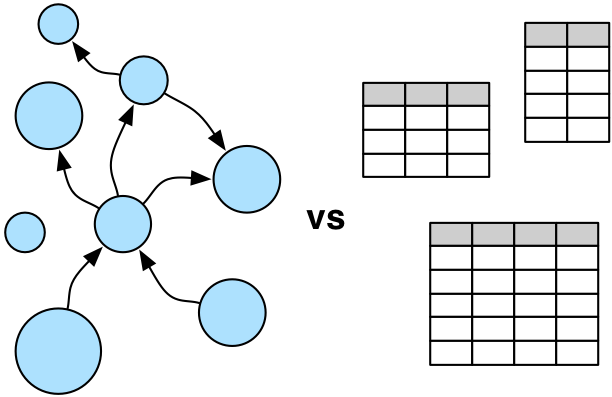Quantum Theory with Apache's Tinkerpop - Gremlin
Page 1 of 1
 Quantum Theory with Apache's Tinkerpop - Gremlin
Quantum Theory with Apache's Tinkerpop - Gremlin
Found this interesting as a new "tool":
https://tinkerpop.apache.org/#
http://www.slideshare.net/slidarko/gremlins-graph-traversal-machinery
Rodriguez, M.A., Watkins, J.H., "Quantum Walks with Gremlin," GraphDay '16 Proceedings, Austin Texas, January 2016.
https://www.slideshare.net/slidarko/quantum-processes-in-graph-computing

The Benefits of Graph Computing
A graph is a structure composed of vertices and edges. Both vertices and edges can have an arbitrary number of key/value-pairs called properties. Vertices denote discrete objects such as a person, a place, or an event. Edges denote relationships between vertices. For instance, a person may know another person, have been involved in an event, and/or was recently at a particular place. Properties express non-relational information about the vertices and edges. Example properties include a vertex having a name, an age and an edge having a timestamp and/or a weight. Together, the aforementioned graph is known as a property graph and it is the foundational data structure of Apache TinkerPop.
If a user's domain is composed of a heterogenous set of objects (vertices) that can be related to one another in a multitude of ways (edges), then a graph may be the right representation to use. In a graph, each vertex is seen as an atomic entity (not simply a "row in a table") that can be linked to any other vertex or have properties added or removed at will. This empowers the data modeler to think in terms of actors within a world of complex relations as opposed to, in relational databases, statically-typed tables joined in aggregate. Once a domain is modeled, that model must then be exploited in order to yield novel, differentiating information. Graph computing has a rich history that includes not only query languages devoid of table-join semantics, but also algorithms that support complex reasoning: path analysis, vertex clustering and ranking, subgraph identification, and more. The world of applied graph computing offers a flexible, intuitive data structure along with a host of algorithms able to effectively leverage that structure.
https://tinkerpop.apache.org/#
http://www.slideshare.net/slidarko/gremlins-graph-traversal-machinery
Rodriguez, M.A., Watkins, J.H., "Quantum Walks with Gremlin," GraphDay '16 Proceedings, Austin Texas, January 2016.
https://www.slideshare.net/slidarko/quantum-processes-in-graph-computing

The Benefits of Graph Computing
A graph is a structure composed of vertices and edges. Both vertices and edges can have an arbitrary number of key/value-pairs called properties. Vertices denote discrete objects such as a person, a place, or an event. Edges denote relationships between vertices. For instance, a person may know another person, have been involved in an event, and/or was recently at a particular place. Properties express non-relational information about the vertices and edges. Example properties include a vertex having a name, an age and an edge having a timestamp and/or a weight. Together, the aforementioned graph is known as a property graph and it is the foundational data structure of Apache TinkerPop.
If a user's domain is composed of a heterogenous set of objects (vertices) that can be related to one another in a multitude of ways (edges), then a graph may be the right representation to use. In a graph, each vertex is seen as an atomic entity (not simply a "row in a table") that can be linked to any other vertex or have properties added or removed at will. This empowers the data modeler to think in terms of actors within a world of complex relations as opposed to, in relational databases, statically-typed tables joined in aggregate. Once a domain is modeled, that model must then be exploited in order to yield novel, differentiating information. Graph computing has a rich history that includes not only query languages devoid of table-join semantics, but also algorithms that support complex reasoning: path analysis, vertex clustering and ranking, subgraph identification, and more. The world of applied graph computing offers a flexible, intuitive data structure along with a host of algorithms able to effectively leverage that structure.
 Re: Quantum Theory with Apache's Tinkerpop - Gremlin
Re: Quantum Theory with Apache's Tinkerpop - Gremlin
This app "Grakn" is based on Tinkerpop. Looks pretty text heavy overall and not that adaptable for a Charge Field- Molecule type engine ... has a decent looking rules engine that can load from JSON/SQL etc. and can write to/from a database:
https://grakn.ai/pages/documentation/grakn-dashboard/visualiser.html
https://grakn.ai/pages/documentation/grakn-dashboard/visualiser.html
 Similar topics
Similar topics» David Bohm: Father of Quantum Theory
» A Quantum Theory containing Photons, Rotations and Linear Force
» Dr. Randell Mill's - Black Light Power - Unified Quantum Theory
» Order theory
» New Particles? No, Bad Theory
» A Quantum Theory containing Photons, Rotations and Linear Force
» Dr. Randell Mill's - Black Light Power - Unified Quantum Theory
» Order theory
» New Particles? No, Bad Theory
Page 1 of 1
Permissions in this forum:
You cannot reply to topics in this forum